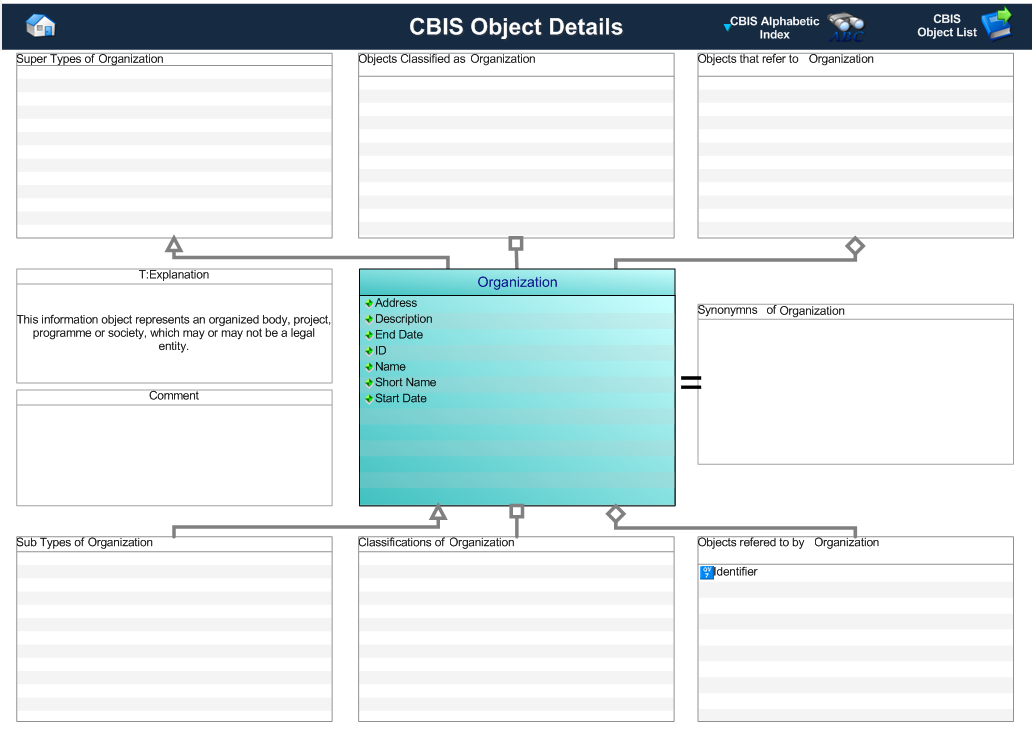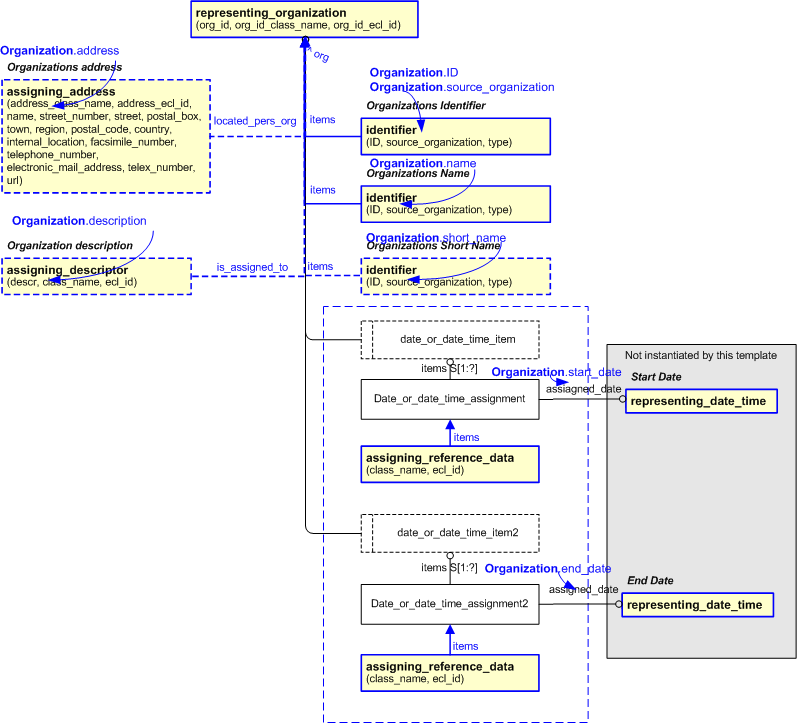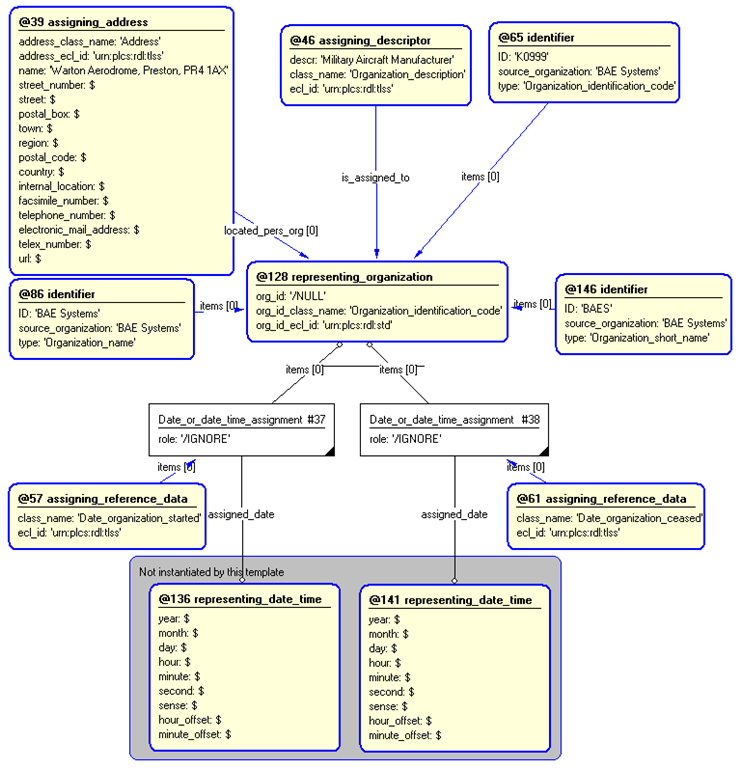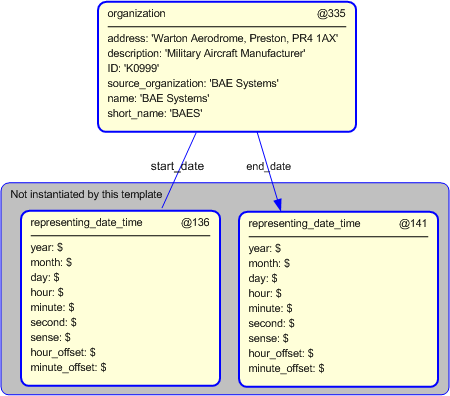Template:— organization (org)
Context:— UK_Defence |
Date: 2009/04/17 10:13:34
Revision: 1.3
|
This section specifies the template organization.
NOTE
The template has been defined in the context of
UK_Defence.
Refer to the business context for details of related templates.
NOTE
An explanation of a template and the associated instantiation path is
provided in the
Template overview
section.
This template describes how to represent a UK_Defence organization, using
Organization.
For further information about the representation of an organization, see below.
This information object represents an organized body, project, programme or society,
which may or may not be a legal entity.
Figure 1 — Graphical Representation for Business Object Organization
|
Attribute name
|
Attribute description
|
Attribute type
|
Optionality
|
| Address |
This is the (list of) address(s) of the organization. |
Intrinsic |
Optional (0:?) |
| Description |
This is a description of the Organization. |
Intrinsic |
Optional |
| End Date |
This is the date on which the Organization ceased to exist. |
Intrinsic |
Optional |
| ID |
This is the identifier of the Organization. |
Identifier |
Mandatory |
| Name |
This is the full name of the organization - the name by which it is
referenced in any legal correspondence.
|
Intrinsic |
Mandatory |
| Short Name |
This is a short name by which the Organization may additionally be known |
Intrinsic |
Optional |
| Start Date |
This is the date on which the organization came into being |
Intrinsic |
Optional |
Table 1 — Organization attribute details
The EXPRESS-G diagram in
Figure
2
shows the templates and EXPRESS entities that are required
to represent the template
"organization".
The text highlighted in blue shows the template parameters.
Figure 2 — An EXPRESS-G representation of the Information model for organization
The graphic for the template to be used in other EXPRESS-G diagrams
is shown in Figure
3
below.
Figure 3 — The graphical representation of the organization template
The following input parameters are defined for this template:
This is the (list of) address(s) of the organization.
This is a description of the Organization.
This is the date on which the Organization ceased to exist
The identifier of the organization.
The organization that created the associated identifier.
This is the full name of the organization - the name by which it is
referenced in any legal correspondence.
This is a short name by which the Organization may additionally be known.
This is the date on which the Organization came into being.
The following reference parameters are defined for this template:
Allow the
Organization
entity instantiated in this path to be referenced when this template is used.
Note: The
Organization
entity can be referenced in a template path by:
%^target = $organization.organization%
where
target
is the parameter to which the
Organization
is bound.
The following parameter combinations specify a uniqueness constraint:
Unique constraint: Unique Organization
Each instance of the
entity
(
Organization)
within the data set shall be uniquely identified
by a combination of the following parameters on this
template (organization) namely:
ID,
source_organization,
name.
The
instance is
referenced by the following template parameter:
organization.
The instantiation path shown below specifies the entities that are to be
instantiated by the template.
A description of templates and the syntax for the instantiation path is
provided in the
Templates Help/Information section.
/
representing_organization(
org_id='/NULL',
org_id_class_name='Organization_identification_code',
org_id_ecl_id='urn:plcs:rdl:std')/
%^organization = $representing_organization.org%
-- [optional address] /
assigning_address(
address_class_name='Address',
address_ecl_id='urn:plcs:rdl:uk_defence',
name=@address,
street_number='$',
street='$',
postal_box=''$,
town='$',
region='$',
postal_code='$',
country='$',
internal_location='$',
facsimile_number='$',
telephone_number='$',
electronic_mail_address='$',
telex_number='$',
url='$',
located_pers_org=^organization)/
-- [optional description] /
assigning_descriptor(
descr=@description,
class_name='Organization_description',
ecl_id='urn:plcs:rdl:uk_defence',
is_assigned_to=^organization)/
/
identifier(
ID=@ID,
source_organization=@source_organization,
type='Organization_identification_code',
items=^organization)/
/
identifier(
ID=@name,
source_organization=@source_organization,
type='Organization_name',
items=^organization)/
-- [optional short_name] /
identifier(
ID=@short_name,
source_organization=@source_organization,
type='Organization_short_name',
items=^organization)/
-- [optional end_date] Date_or_date_time_assignmentDate_or_date_time_assignment.role = '/IGNORE'
Date_or_date_time_assignment.items ->
^organization
Date_or_date_time_assignment.assigned_date ->
@end_date%^end_date =
Date_or_date_time_assignment%
/
assigning_reference_data(
items=^end_date,
class_name='Date_organization_ceased',
ecl_id='urn:plcs:rdl:uk_defence')/
-- [optional start_date] Date_or_date_time_assignmentDate_or_date_time_assignment.role = '/IGNORE'
Date_or_date_time_assignment.items ->
^organization
Date_or_date_time_assignment.assigned_date ->
@start_date%^start_date =
Date_or_date_time_assignment%
/
assigning_reference_data(
items=^start_date,
class_name='Date_organization_started',
ecl_id='urn:plcs:rdl:uk_defence')/
The following entities are instantiated with attributes as specified:
The instance diagram in Figure
4
shows an example of the EXPRESS entities and templates that are instantiated by the template:
/organization(address='Warton Aerodrome, Preston, PR4 1AX', description='Military Aircraft Manufacturer', end_date='01-01-2010', ID='K0999', source_organization='BAE Systems', name='BAE Systems', short_name='BAES', start_date='01-01-1990')/
(an illustration of the consolidated organization template is shown in
Figure
5 below.)
Figure 4 — Entities instantiated by organization template
The instance diagram in
Figure
5
shows the graphic symbol for the template that is to be
used in other instance diagrams. The example template is:
/organization(address='Warton Aerodrome, Preston, PR4 1AX', description='Military Aircraft Manufacturer', end_date='01-01-2010', ID='K0999', source_organization='BAE Systems', name='BAE Systems', short_name='BAES', start_date='01-01-1990')/
Figure 5 — Instantiation of organization template
Characterizations
No common characterizations of the template
organization
have been identified. However, the ISO 10303-239 EXPRESS model
may enable other assignments to the entities instantiated by the template.




